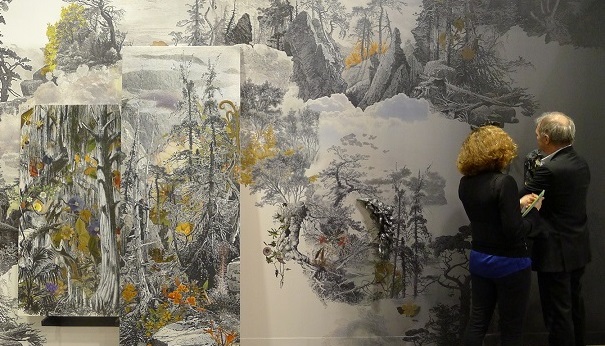Reviews & Articles
Hong Kong’s Art Year: Strong All-year Round
John BATTEN
at 10:09pm on 21st March 2017

Caption:
Wallpaper and mixed media installation by Francesco Simeti at Art Basel Hong Kong 2016.
(原文以英文發表,題為〈香港藝術足夠強大全年欣賞〉。)
Another year! The recent Lunar New Year holidays have ended and the rhythms of the art year have begun. From now until summer, there is a range of monthly exhibitions in a variety of private and public spaces. Then, around late-July and into August is a six-week break, the period of ‘summer exhibitions’, which are really stock shows or ‘fill-in’ group exhibitions. There is a short spurt of art activity until mid-December. Then Christmas/New Year holidays sees a quiet lull through to the Lunar New Year before it all begins again. Hong Kong’s art year is predictable; tracking seasonal weather, school holidays and roughly following the retail industry’s highs and lows.
Hong Kong biggest art fair, Art Basel Hong Kong, returns at the end of March, and around that time you might hear the term ‘Hong Kong Art Week’, or something similar. Other cities have similarly designated weeks, but such a tag ignores all the art events, exhibitions, talks, performances and screenings during the rest of the year. It helps neither artist nor gallery to designate any week as an especial art week. This particular week could be called ‘Art Basel Week’, as the fair is big enough to justify that designation, but it would be even better to drop all silly marketing tags for individual events or periods of time. Our art year is strong enough to be appreciated all year round!
In the supposedly quiet month of January I saw Shifting Objectives at the recently opened M+ Pavilion at the West Kowloon Cultural District. It is the first design exhibition since 2014 when M+ presented the beginnings of its architecture collection. The 2014 exhibition showed original plans, concept drawings, photographs and architectural models. Particularly interesting were the conceptual ideas and architectural models by the architects invited to propose the design for the M+ museum at the West Kowloon Cultural District. This previous willingness to engage with the public in the delicate process of architectural selection is in contrast with the Hong Kong government’s recent immediate and contentious appointment of architect Rocco Yim to design the proposed Palace Museum for the West Kowloon Cultural District. Justifying, in part, his appointment, “the WKCDA Management considers that HKPM is a unique museum with (a) very special nature to showcase the precious collections, culture and history of the Palace Museum.”
Shifting Objectives displayed recent additions to the museum’s growing design collection. The show includes graphic design, industrial products, furniture and design-related ideas and introduces aspects of post-WWII modernist design in Asia that is, as curator Aric Chen explains, M+'s first steps in collecting design in "a region where the institutional narration of design remains a fledgling effort."
The exhibition starts and ends with two seminal displays that straddle the objects on show. At the very start of the exhibition are two photographs by photographer Ishimoto Yasuhiro depicting a minimal interior and garden from the 17th century Katsura imperial villa in Kyoto. These images were reproduced in a book by the Bauhaus instructor Herbert Bayer in 1960. The minimalist, simple, uncluttered lines of historical Japanese built form are clearly linked by Bayer to the functional design of 20th century modernism.
Then, at the very end of the exhibition is a plastic object a little larger than a hair-dryer. This object or product, we are told, was specifically designed and manufactured to appear in a video. The exhibition curators explain that “artist-designers Revital Cohen and Tuur Van Balen worked with choreographer Alexander Whitley to design a product whose only function is to choreograph its own manufacture.” This product appears in the artists’ video, 75 Watt, depicting our post-modern homage to the process and then objectification of material possessions. In the video, production line workers in a Zhongshan, Guangdong Province factory have been taught dance-action choreography to assemble the object. And just as Fritz Lang’s film Metropolis (1927) depicted a world of machine-dominated workers, 75 Watt “reflects on mass-production and the role of scientific management in mechanizing the human body in the name of efficiency.” It is a witty, arty conclusion to a serious design exhibition that covers aspects of post-war design in India, China, Hong Kong and Japan with a further section on recent transnational design.
However, a continuing challenge for M+ is to build a collection of depth, wider than the predominantly European-inspired modernism seen in Shifting Objectives. The future selection of excellent regional and vernacular design will be the challenge: where does the beginning end? And, no doubt, even with the prestige of the Palace Museum and its historical, national and “precious collections” there are challenges. The collection and its exhibition must be vital, appealing and relevant for Hong Kong.
This article was originally published in Perspective architectural magazine, March 2017.
原文刊於Perspective,2017年3月。
